IEEE Wearable Devices and Sensor Informatics at HIMSS 2014
By Surapa Thiemjarus and Jing Liu
The 2014 HIMSS Conference in Orlando, Florida, showcased an Intelligent Medical Home and a Connected Patient Gallery, along with keynote speeches and technical presentations. We bring you photos and highlights of the Conference.
The 2014 Healthcare information and Health Management Systems Society (HIMSS) Conference and Exhibition took place on 23-27 February in the Orange County Convention Center, Orlando, Florida. This year, the industry-leading meeting assembled more than 37,000 healthcare professionals and 1,200 exhibitors from around the world for a week focusing on better health through information technology and global effort on optimizing health engagements and outcomes based on the latest technological developments.
The keynote speakers include Hillary Clinton, the Former Secretary of State and Former U.S. Senator from New York; Mark Bertolini, the Chief Executive Officer of Aetna; Dr. Karen DeSalvo, the National Coordinator for Health Information Technology; Marilyn Tavenner, the Administrator of Centers for Medicare and Medicaid Services; and Erik Weihenmayer, a world class blind adventurer.

Figure 1: Hillary Clinton Keynote Speech at the Valencia Ballroom.
In addition to the featured keynote speeches, HIMSS 2014 also had several highlights. The interactive guided tour to the Intelligent Medical Home (IMH) in the Intelligent Hospital™ Pavilion (IHP), which showcased solutions from over 60 vendors and demonstrated seamless integration of technology, such as Auto-ID, biometrics, near field communication, radio frequency identification, real time location system, sensors, wireless, and mobile devices, for enhancing healthier livings. The Connected Patient Learning Gallery showcased technology tools that could aid provider and patient engagement and maintain better personal health. The Interoperability Showcase™ demonstrated collaborative technology vital to the realization of connected health and patient empowerment. The gallery incorporated an interoperability simulation area, as well as engaging interactive clinical use case demonstrations. The Startup Showcase™ presented selected exhibitions and demonstrations from 44 of the most promising new health IT companies.

Figure 2: Exhibition Hall.
HIMSS 2014 also provided education sessions, roundtable discussions, e-sessions, pre-conference workshops and symposia, as well as career services and networking opportunities. The education sessions of HIMISS 2014 invited healthcare leaders to deliver the latest ideas and technological advances in Health IT.
On the day before the main conference, the Intelligent Hospital Association, the RFID in Healthcare Consortium (RHCC), the IEEE Engineering in Medicine and Biology Society (EMBS), and IEEE Life Sciences jointly presented a pre-conference symposium on “Join the Evolution to the Revolution – Transforming and Innovating Healthcare through New Technologies” at Hilton Orlando. During the mobile health education session of the main conference, Prof. Guang-Zhong Yang, Prof. Yuan-Ting Zhang, and Prof. May D. Wang who was also the Chair of this session gave a joint lecture on “Wearable Devices and Sensor Informatics for Pervasive Healthcare”. With demographic changes associated with the aging population and increasing number of people living alone, the requirement and practical provision of future healthcare delivery are changing rapidly. From the perspective of wearable or implantable wireless sensory devices for providing early warnings of potential problems, this lecture discussed the future healthcare trend for shorter hospital stay and better community care at a local level built on intelligent and pervasive information links between patients and specialist centers. The lecture attracted extensive attention and packed with HIMSS 2014 participants, reflecting increasing interests in wearable devices and their growing importance to healthcare.

Figure 3: Wearable Devices and Sensor Informatics for Pervasive Healthcare” Education Session.
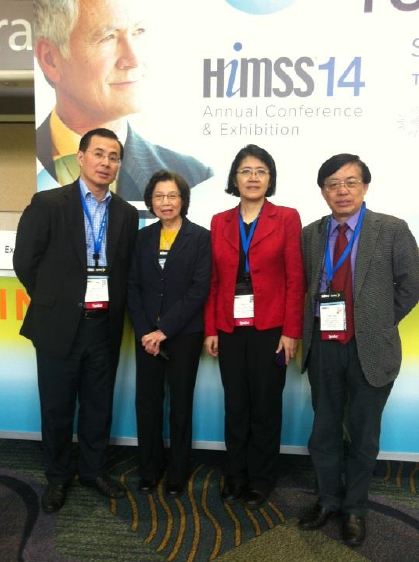
Figure 4: (From left to right) Prof. Guang-Zhong Yang, Ms. Bichlien Hoang (Senior Program DirectorLife Sciences New Initiative at IEEE), Prof. May D. Wang, and Prof. Yuan-Ting Zhang
Prof. Guang-Zhong Yang, IEEE Fellow, the Director of Hamlyn Center at Imperial College London and the Editor-in-Chief of IEEE Journal Biomedical and Health Informatics (J-BHI) offered his insight into sensor informatics for future healthcare. He identified the technical challenges related to Body Sensor Network (BSN) design, power scavenging, and low power wireless communication for providing “ubiquitous” and “pervasive” monitoring of physical, physiological, and biochemical parameters in any environment without activity restriction and behavior modification. He also highlighted the need for autonomic sensing including context-aware sensing, mutli-sensor fusion and data mining for recovering both direct and surrogate signs for general well-being and chronic disease management.
Focusing on cardiovascular health informatics, Prof. Yuan-Ting Zhang, IEEE Fellow, the Director of Joint Research Center for Biomedical Engineering at the Chinese University of Hong Kong and Key Lab for Health Informatics of Chinese Academy of Sciences (HICAS) at SIAT, presented the “MINDS” (Miniaturization, Intelligent, Network, Digitalization, and Standardization) design of wearable medical systems and flexible sensors with a wearable cuffless blood pressure measuring device as an example. He also discussed the challenges and opportunities of 8-P (pervasive, predictive, preventive, personalized, precise, participatory, pre-emptive, and patient-centered) medicine for evidence- based CVD healthcare.
Prof. May D. Wang from Georgia Institute of Technology and Emory University, the Chair of IEEE- EMBS Biomedical and Health Informatics Technical Committee and Georgia Research Alliance Distinguished Cancer Scholar, made the last presentation on “Personalized Care Using Informatics”. Dr. Wang explained the impact of health IT and informatics on patient-centric and evidence-based medicine first; followed by showing how to manage chronic and acute disease conditions such as CVD by integrating both EMR and PHR (Personalize Health Record) through Big Data analytics; and highlighted the potential of incorporating clinical genomics sensing into EMR/PHR for personalized and predictive care.
An exhibition by IEEE was located in the Intelligent Hospital™ Pavilion (IHP), showcasing healthcare IT activities by the IEEE Life Science Portal, IEEE Standards Association, IEEE-EMBS, IEEE Computer Society, and IEEE Communication Society.
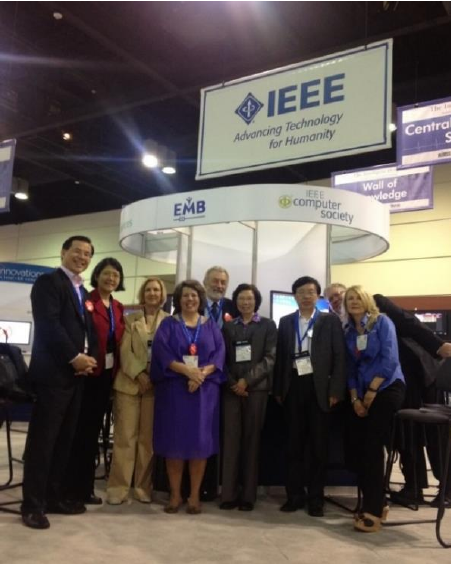
Figure 5: IEEE Showcase
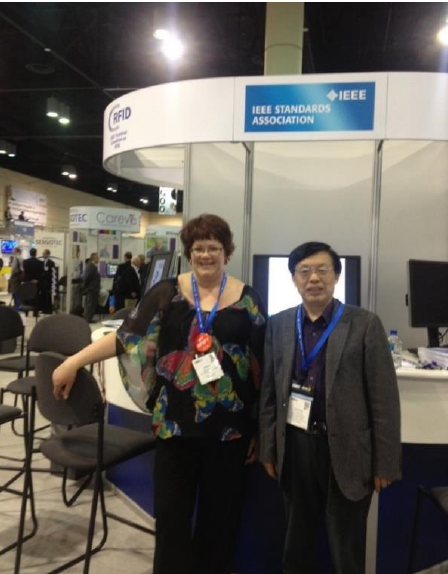
Figure 6: Kathryn M. Bennett, Staff Liaison for IEEE Standards Association and Y.T. Zhang, the Chair of IEEE Working Group for International Standard on wearable cuffless blood pressure measuring devices.
Next to the exhibition booth is the Intelligent Medical Home (IMH), which demonstrated the longitudinal flow of real-time data from the patients at home to primary caregivers at local hospitals through information technologies. These exhibits provided a practical overview of how diverse technologies such as biometrics, RFID, wireless sensors and mobile devices could be seamlessly integrated to enhance patient care, improve efficiency, optimize workflow, reduce medicare cost, and manage healthcare resources across a broad spectrum of healthcare settings – from hospitals to patients’ homes. These exhibits gave a snapshot of the joint efforts from different sectors ranging from academics, industries and hospitals to governments for delivering better healthcare by leveraging the latest advances in IT.

Figure 7: (5th from left) Dr. Bruce Wheeler, President of IEEE EMBS, and (1st from right) Dr. Paul Frisch, the designer of the Intelligent Medical Home, at IHP.
Next year, the HIMSS Conference and Exhibition will be held at McCormick Place, Chicago on April 12-16, 2015.
Contributors
 Surapa Thiemjarus is a researcher from the National Electronics and Computer Technology Center (NECTEC), National Science and Technology Development Agency (NSTDA), Thailand. She received her PhD degree in Computing from Imperial College, UK. Her research interests include context-aware and pervasive sensing, body sensor networks and applications, sensor fusion, machine learning, pattern recognition, sound and signal processing, and assistive technologies. Read more
Surapa Thiemjarus is a researcher from the National Electronics and Computer Technology Center (NECTEC), National Science and Technology Development Agency (NSTDA), Thailand. She received her PhD degree in Computing from Imperial College, UK. Her research interests include context-aware and pervasive sensing, body sensor networks and applications, sensor fusion, machine learning, pattern recognition, sound and signal processing, and assistive technologies. Read more
 Jing Liu is currently working as a short-term research assistant in Joint Research Center for Biomedical Engineering at the Chinese University Hong Kong (CUHK), Shatin, N.T., Hong Kong. Meanwhile, she is a senior student of Wuhan University majoring in Computer Science and she is going to pursue her Ph.D. degree in Biomedical Engineering at CUHK in the autumn of 2014. Her research interests include wearable medical device and physiological modeling. Read more
Jing Liu is currently working as a short-term research assistant in Joint Research Center for Biomedical Engineering at the Chinese University Hong Kong (CUHK), Shatin, N.T., Hong Kong. Meanwhile, she is a senior student of Wuhan University majoring in Computer Science and she is going to pursue her Ph.D. degree in Biomedical Engineering at CUHK in the autumn of 2014. Her research interests include wearable medical device and physiological modeling. Read more







 Surapa Thiemjarus is a researcher from the National Electronics and Computer Technology Center (NECTEC), National Science and Technology Development Agency (NSTDA), Thailand. She received her PhD degree in Computing from Imperial College, UK. Her research interests include context-aware and pervasive sensing, body sensor networks and applications, sensor fusion, machine learning, pattern recognition, sound and signal processing, and assistive technologies.
Surapa Thiemjarus is a researcher from the National Electronics and Computer Technology Center (NECTEC), National Science and Technology Development Agency (NSTDA), Thailand. She received her PhD degree in Computing from Imperial College, UK. Her research interests include context-aware and pervasive sensing, body sensor networks and applications, sensor fusion, machine learning, pattern recognition, sound and signal processing, and assistive technologies.  Jing Liu is currently working as a short-term research assistant in Joint Research Center for Biomedical Engineering at the Chinese University Hong Kong (CUHK), Shatin, N.T., Hong Kong. Meanwhile, she is a senior student of Wuhan University majoring in Computer Science and she is going to pursue her Ph.D. degree in Biomedical Engineering at CUHK in the autumn of 2014. Her research interests include wearable medical device and physiological modeling.
Jing Liu is currently working as a short-term research assistant in Joint Research Center for Biomedical Engineering at the Chinese University Hong Kong (CUHK), Shatin, N.T., Hong Kong. Meanwhile, she is a senior student of Wuhan University majoring in Computer Science and she is going to pursue her Ph.D. degree in Biomedical Engineering at CUHK in the autumn of 2014. Her research interests include wearable medical device and physiological modeling.  Xiao-Rong Ding is currently pursuing her Ph.D. degree in Biomedical Engineering at the Joint Research Centre for Biomedical Engineering of The Chinese University of Hong Kong, Shatin, N.T., Hong Kong. Her research interests include wearable medical devices, CVD health informatics and physiological modelling.
Xiao-Rong Ding is currently pursuing her Ph.D. degree in Biomedical Engineering at the Joint Research Centre for Biomedical Engineering of The Chinese University of Hong Kong, Shatin, N.T., Hong Kong. Her research interests include wearable medical devices, CVD health informatics and physiological modelling. 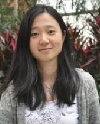 Ni Zhao is currently an assistant professor at the Department of Electronic Engineering at the Chinese University of Hong Kong, Shatin, N.T., Hong Kong. She received her Ph.D. degree in Physics from the University of Cambridge (UK) in 2008. Her research interest covers optoelectronic, electronic and electrochemical devices based on organic and nanostructured materials; spectroscopic characterization of the physical processes in nanostructured thin films, structures, and devices.
Ni Zhao is currently an assistant professor at the Department of Electronic Engineering at the Chinese University of Hong Kong, Shatin, N.T., Hong Kong. She received her Ph.D. degree in Physics from the University of Cambridge (UK) in 2008. Her research interest covers optoelectronic, electronic and electrochemical devices based on organic and nanostructured materials; spectroscopic characterization of the physical processes in nanostructured thin films, structures, and devices. 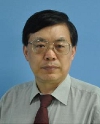 Yuan-Ting Zhang is currently the Director of Joint Research Center for Biomedical Engineering and Professor of Department of Electronic Engineering at the Chinese University of Hong Kong (CUHK), Hong Kong, China. He serves concurrently the Director of the Key Lab for Health Informatics of the Chinese Academy of Sciences (HICAS) at SIAT, Shenzhen, China. He is the founder and the first Director of the SIAT Institute of Biomedical and Health Engineering under the Chinese Academy of Sciences. His research spans several fields including wearable medical devices, flexible biosensors, BSN security, neuro-physiological modeling, CVD health informatics, and m-u-p-Heath technologies.
Yuan-Ting Zhang is currently the Director of Joint Research Center for Biomedical Engineering and Professor of Department of Electronic Engineering at the Chinese University of Hong Kong (CUHK), Hong Kong, China. He serves concurrently the Director of the Key Lab for Health Informatics of the Chinese Academy of Sciences (HICAS) at SIAT, Shenzhen, China. He is the founder and the first Director of the SIAT Institute of Biomedical and Health Engineering under the Chinese Academy of Sciences. His research spans several fields including wearable medical devices, flexible biosensors, BSN security, neuro-physiological modeling, CVD health informatics, and m-u-p-Heath technologies.  Henry Ip is a post-doctoral research fellow at the Hamlyn Centre, Imperial College London, UK. He is specialised in bio-inspired architectures for low-power Application Specific Integrated Circuits (ASICs), miniature amperometric ASIC arrays for subcellular electrochemical recordings and nano-power continuous-time filters.
Henry Ip is a post-doctoral research fellow at the Hamlyn Centre, Imperial College London, UK. He is specialised in bio-inspired architectures for low-power Application Specific Integrated Circuits (ASICs), miniature amperometric ASIC arrays for subcellular electrochemical recordings and nano-power continuous-time filters.  Guang-Zhong Yang is director and co-founder of the Hamlyn Centre, Imperial College London, UK. Professor Yang's main research interests are in medical imaging, sensing and robotics. He is a Fellow of the Royal Academy of Engineering, fellow of IEEE, IET, AIMBE and a recipient of the Royal Society Research Merit Award and listed in The Times Eureka 'Top 100' in British Science.
Guang-Zhong Yang is director and co-founder of the Hamlyn Centre, Imperial College London, UK. Professor Yang's main research interests are in medical imaging, sensing and robotics. He is a Fellow of the Royal Academy of Engineering, fellow of IEEE, IET, AIMBE and a recipient of the Royal Society Research Merit Award and listed in The Times Eureka 'Top 100' in British Science.